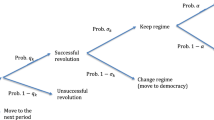Abstract
The article deals with the question if the cleavage concept of Lipset and Rokkan can be applied to the rise of National Socialism at the polls and as a mass-integration party. Voter fluctuations within and between political camps are analysed by means of ecological regression analysis as well as the social composition of the NSDAP electorate. Furthermore the social fabric of NSDAP party members between 1925 and 1933 is decribed in terms of the cleavage concept.




Similar content being viewed by others
Notes
If we consider that the social characteristic ‚’Catholic’ encompasses both believers and nonbelievers and churchgoing and non-practicing members of the Catholic Church, we get a somewhat better idea of the immunizing function exerted by political Catholicism, since it only applies, of course, to practising Catholics. This does not necessarily imply that the Centre Party voters were more democratic or less authoritarian than the bulk of the National Socialist supporters (the same is certainly true with regard to the similarly immune partisans of the Communist Party).
References
Almond, G.A. and Powell, G.B. (1978) Comparative Politics. System, Process, and Politics, Boston/Toronto: Little, Brown.
Falter, J.W. (1991) Hitlers Wähler, München: C.H.Beck, pp. 429–440.
Falter, J.W. (2013) Zur Soziographie des Nationalsozialismus. Studien zu den Wählern und Mitgliedern der NSDAP, Historical Social Research 25: 7–374..
Falter, J.W. and Bömermann, H. (1989) ‘Das Wählerpotential Politischer Teilkulturen in Der Weimarer Republik’, in K. Megerle and D. Lehnert (eds.) Politische Identität und nationale Gedenktage. Zur politischen Kultur in der Weimarer Republik, Opladen: Westdeutscher Verlag, pp. 281–305.
Falter, J., Lindenberger, T. and Schumann, S. (1986) Wahlen und Abstimmungen in der Weimarer Republik. Materialien zum Wahlverhalten 1919–1933, München: C.H.Beck.
Lipset, S.M. (1960) Political Man: The Social Bases of Politics, Baltimore: Johns Hopkins University Press.
Lipset, S.M. and Rokkan, S. (1990) ‘Cleavage Structures, Party Systems and Voter Alignments’, in Mair (1990: 91–38), in P. Mair (ed.) The West European Party System, Oxford: Oxford University Press, pp. 91–138.
Lohmöller, J.-B. and Bömermann, H. (1993) ’Ökologische Inferenz: Eine Anwendungsorientierte Einführung’, in Berliner Arbeitshefte und Berichte zur sozialwissenschaftlichen Forschung, Band 82 Berlin: Freie Universität Berlin, Zentralinstitut für sozialwissenschaftliche Forschung.
Stinchcombe, A. (1975) ‘Social Structure and Politics’, in F.I. Greenstein u and N.W. Po1sby (eds.) Handbook of Political Science, Vol. 3: Macropolitical Theory, Reading Mass: Addison-Wesley.
Winkler, J. (1992) Sozialstruktur und Parteiensystem in Deutschland 1912–1924, Historical Social Research 17 (1): 52–103.
Author information
Authors and Affiliations
Additional information
This was originally delivered as the Stein Rokkan Lecture at the ECPR Joint Sessions, University of Mainz, 13 March 2013.
If and only if the relatively strict assumptions of this technique are met by the data will the estimates represent a true measure of the voter movement that actually occurred. If the data cannot satisfy these assumptions, these estimates may still be regarded as the statistically best indicators of the voter exchange that took place between the individual subcultures and parties. Unfortunately we are not able to determine from the available data if all the conditions of ecological regression analysis have been adequately satisfied. Furthermore, this technique is very sensitive to differing model specifications. Its results, therefore, should be interpreted quite cautiously and restricted to differences of magnitude, not to small percentage variations. I am, however, quite optimistic that the results approximate what actually happened, since different model specifications and various multiple ecological regression analyses based on different aggregations produce approximately the same results, which in turn closely coincide in magnitude with normal multiple regression analyses using so-called change variables. The following estimates of vote changes between parties and political camps were calculated on the basis of the Weimar Republic communities by means of an extension of ecological regression analysis using so-called moderator variables (Lohmöller and Bömermann, 1993).
Rights and permissions
About this article
Cite this article
falter, j. Political Cleavages In The Weimar Republic and the Rise of National Socialism. Eur Polit Sci 13, 106–116 (2014). https://doi.org/10.1057/eps.2013.41
Published:
Issue Date:
DOI: https://doi.org/10.1057/eps.2013.41




